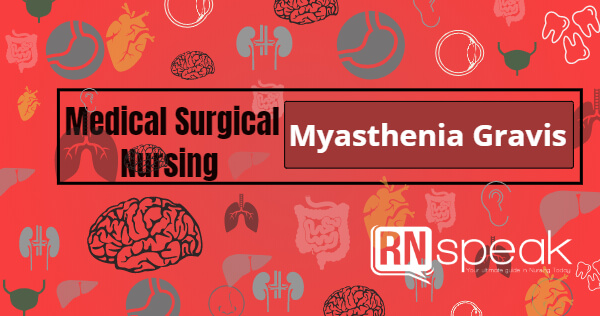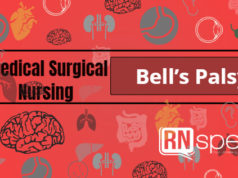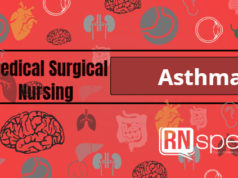Myasthenia gravis is a common condition that affects the neuromuscular junction (NMJ) in the skeletal muscles. It affects roughly 20 people out of every 100,000 in the United States. Myasthenia gravis, like other autoimmune disorders, tends to occur in persons who are predisposed to such conditions, and there is now no specific remedy available. However, current treatment options concentrate on lowering inflammation and improving the management of symptoms experienced by those affected.
Definition
Myasthenia gravis is a relatively rare acquired autoimmune condition characterized by an antibody-mediated blockage of neuromuscular transmission, which results in skeletal muscle weakening and fast muscle fatigue. It is an immunological reaction of type II hypersensitivity. The fundamental pathophysiology is a decrease in the number of acetylcholine receptors. The decline produces a distinct pattern of progressively reduced muscular strength with repeated use and muscle strength recovery after a time of rest. In an emergency, the most serious aspect of myasthenia gravis is the acute worsening of weakness, which leads to neuromuscular respiratory failure.
Classification
Myasthenia gravis (MG) can be categorized into different subgroups based on the clinical characteristics and antibodies involved. Each group responds to treatment differently and has a prognosis value.
- Early-onset MG. Age at onset less than 50 years with thymic hyperplasia
- Late-onset MG. Age at onset greater than 50 years with thymic atrophy
- Thymoma-associated MG
- MG with anti-MuSK (muscle-specific kinase) antibodies
- Ocular MG. Symptoms are only from periocular muscles
- MG with no detectable acetylcholine and MuSK antibodies
The Myasthenia Gravis Foundation of America (MGFA) clinical classification divides MG into 5 main classes based on the clinical features and the disease severity.
- Class I. Involves any ocular muscle weakness, including weakness of eye closure. All other muscle groups are normal.
- Class II. Involves mild weakness of muscles other than ocular. Ocular muscle weakness of any severity may be present.
- Class IIa. Involves predominant weakness of the limb, axial muscles, or both. It may also involve the oropharyngeal muscles to a lesser extent.
- Class IIb. Involves mostly oropharyngeal, respiratory muscles, or both. It can have the involvement of limbs, axial muscles, or both to a lesser extent.
- Class III. Involves muscles other than the ocular muscles moderately. Ocular muscle weakness of any severity can be present.
- Class IIIa. Involves the limb, axial muscles, or both predominantly. The limb, axial muscles, or both can have lesser or equal involvement.
- Class IIIb. Involves the oropharyngeal, respiratory muscles, or both predominantly. The limb, axial muscles, or both can have lesser or equal involvement.
- Class IV. Involves severe weakness of affected muscles. Ocular muscle weakness of any severity can be present.
- Class IVa. Involves limb, axial muscles, or both predominantly. Oropharyngeal muscles can be involved to a lesser degree.
- Class IVb. Involves the oropharyngeal, respiratory muscles, or both predominantly. The limb, axial muscles, or both can have lesser or equal involvement. It also includes clients requiring feeding tubes without intubation.
- Class V. Involves intubation with or without mechanical ventilation, except when employed during routine postoperative management.
Etiology
Myasthenia gravis is idiopathic in most clients. Although the main cause behind its development remains speculative, the end result is a derangement of immune system regulation.
- Antibodies. Antibodies can block the function of a protein called muscle-specific kinase (MuSK). This protein is involved in forming the nerve-muscle junction. Antibodies against this protein can lead to MG).
- Thymus gland. The thymus gland is part of the immune system situated in the upper chest beneath the breastbone. Researchers believe that the thymus gland triggers or maintains the production of the antibodies that block acetylcholine.
- Genetics. Rarely, mothers with MG have children who are born with the disease (neonatal MG). If treated promptly, children generally recover within two months after birth. Some children are born with a rare, hereditary form of MG, called a congenital myasthenic syndrome.
Epidemiology
The overall incidence rate of MG has been estimated at 2.1 to 5.0 per million people per year and has not changed over time. Approximately 15 to 20% of clients with MG experience a crisis in their lifetime, typically within the first 2 years of the diagnosis. MG can occur at any age. Female incidence peaks in the third decade of life, whereas male incidence peaks in the sixth or seventh decade. The mean onset is 28 years in females and 42 years in males. Classically, the overall female-to-male ratio has been considered to be 3:2, with a female predominance in younger adults and a slight male predominance in older adults. The onset of MG at a young age is slightly more common in Asians than in other races.
Pathophysiology
The pathophysiological mechanisms in Myasthenia Gravis (MG) vary depending on the type of antibodies involved. In the case of n-acetylcholine (n-ACh) MG, the antibodies belong to the IgG1 and IgG3 subtypes. These antibodies specifically target the n-ACh receptors found on the postsynaptic membrane of skeletal muscles. When they bind to these receptors, they activate the complement system, which triggers the formation of the membrane attack complex (MAC). The MAC then initiates the degradation process of the receptors, leading to their ultimate destruction.
On the other hand, MuSK MG involves a different type of antibody, specifically the IgG4 subtype. Unlike the antibodies in n-ACh MG, these IgG4 antibodies do not possess the ability to activate the complement system. Instead, they bind to a protein complex called Agrin-LRP4-MuSK, which is essential for the maintenance of the neuromuscular junction (NMJ). This complex plays a crucial role in the distribution and clustering of n-ACh receptors. When the IgG4 antibodies inhibit this complex, it results in a decreased number of n-ACh receptors, contributing to muscle weakness and fatigue in MuSK MG.
To summarize, the pathophysiology of MG depends on the type of antibodies involved. In n-ACh MG, IgG1 and IgG3 antibodies activate the complement system and cause the degradation of n-ACh receptors. In MuSK MG, IgG4 antibodies inhibit the Agrin-LRP4-MuSK complex, leading to a reduced number of n-ACh receptors.
Presentation
The physical examination may reveal normal muscle power because of the fluctuating disease pattern. In such cases, repeated or sustained muscle contractions can demonstrate weakness. The signs and symptoms of MG include the following:
- Extraocular muscle weakness. Around 85% of clients will have this on the initial presentation. Common client complaints include diplopia, ptosis, or both.
- Bulbar muscle weakness. This can be the initial presentation in 15% of clients and causes symptoms like difficulty chewing or frequent choking, dysphagia, hoarseness, and dysarthria. The involvement of facial muscles causes an expressionless face, and neck muscle involvement causes a dropped-head syndrome.
- Limb weakness. This usually involves the proximal muscles more than the distal muscles, with the upper limbs more affected than the lower limbs.
- Myasthenic crisis. It is due to the involvement of the intercostal muscles and diaphragm and is a medical emergency.
Diagnostic Considerations
The diagnosis of Ng is mostly clinical. Laboratory investigations and procedures usually aid in confirming the clinical findings.
- Serologic tests. The anti-AChR Ab test is very specific, and it confirms the diagnosis in clients with classical findings. It is present in four-fifths of clients with generalized MG and only in half of the clients with pure ocular MG. The rest of the clients will demonstrate anti-MuSK antibodies.
- Imaging studies. Imaging of the chest in MG is used to rule out tumors. Radiography may identify a thymoma as an anterior mediastinal mass. A chest CT scan should be obtained to identify or rule out thymoma or thymic enlargement in all cases of MG. MRI can evaluate for intraorbital or intracranial lesions, basal meningeal pathology, or multiple sclerosis.
- Electrodiagnostic studies. Commonly employed tests for MG are the repetitive nerve stimulation (RNS) test and single-fiber electromyography (SFEMG). RNS test is done by stimulating the nerve at 2 to 3 Hz because repeated stimulation depletes the ACh in the NMJ and produces a low excitatory postsynaptic potential. SFEMG records action potential (AP) from individual muscle fibers, thus allowing to record the AP simultaneously from two muscle fibers innervated by a single motor neuron.
- Edrophonium (Tensilon) test. Edrophonium is a short-acting acetylcholinesterase inhibitor that increases the availability of ACh in the NMJ. This is particularly useful for ocular MG, where electrophysiologic testing cannot be performed. It is administered intravenously, and the client is observed for improvement in the symptoms of ptosis or diplopia.
- Ice-pack test. The ice-pack test (placing ice over the lid) assesses the improvement in ptosis and diplopia in ocular MG. The rationale behind this test is that cooling might improve neuromuscular transmission.
Medical Management
Even though no rigorously tested treatment trials have been reported and no clear consensus exists on treatment strategies, MG is one of the most treatable neurologic disorders. Treatment regimens are individualized depending on the severity of the myasthenia, client age, serology status, thymic pathology, concurrent medical issues, client and provider preference, and clinical experience.
- Acetylcholinesterase (AChE) inhibitors. AChE inhibitors and immunomodulating therapies are the mainstays of MG treatment. Pyridostigmine is used for symptomatic treatment only and maintenance therapy. In the mild form of the disease, AChE inhibitors are used initially. Neostigmine is generally used only when pyridostigmine is unavailable.
- Corticosteroids. Immunomodulation can be achieved by various medications, such as commonly used corticosteroids. The corticosteroid regimen should be tailored according to the client’s overall improvement. Because of the delayed onset of effects (3 to 4 months), steroids are not recommended for routine use in the emergency department.
- Nonsteroidal immunosuppressant agents. These agents should be used alone when corticosteroids are contraindicated or refused. A nonsteroidal IS agent should be used initially in conjunction with corticosteroids when the risk of steroid side effects is high based on medical comorbidities. The mainstay of therapy is still azathioprine. Cyclosporine and occasionally methotrexate ad cyclophosphamide are used for severe cases, while tacrolimus is under investigation.
- Plasmapheresis. Plasmapheresis or plasma exchange is believed to act by removing circulating humoral factors from the circulation. It is used as an adjunct to other immunomodulatory therapies and as a tool for crisis management. It is often the initial treatment of choice in a myasthenic crisis.
- Thymectomy. Removal of thymoma is essential to prevent local dissemination and systemic metastases. In a late-onset client with MG and thymoma, thymectomy probably does not change the course of MG. Thymectomy has been proposed as a first-line therapy in most clients with generalized myasthenia. Thymectomy is not recommended in clients with antibodies to MuSK, because of the typical thymus pathology, which is very different from the more common type of MG characterized by seropositivity for AChR antibodies. Thymectomy may induce remission more frequently in young clients with a short duration of disease.
Nursing Management
As myasthenia gravis progresses, clients with the condition are likely to require increasing management and support from a range of healthcare professionals, including nurses.
Nursing Assessment
Clients with MG can present with a wide range of signs and symptoms depending on the severity of the disease.
Subjective Cues
- Fatigue
- Sleep disturbances
- Visual disturbances
- Shortness of breath
Objective Cues
- Generalized weakness
- Ptosis
- Double vision
- Fever
- Sagging or expressionless face
- Horizontal smile
- Drooping of the corners of the mouth
- Myasthenic snarl
- Inability to whistle, suck through a straw, or blow up a balloon
- Exposed sclerae
- Bell’s phenomenon (upward rolling of eyeballs during lid closure)
- Difficulty chewing
Nursing Diagnoses
- Ineffective breathing pattern related to neuromuscular weakness and decreased energy
- Impaired verbal communication related to facial muscle weakness
- Impaired swallowing related to the neuromuscular impairment of laryngeal/pharyngeal muscles
- Anxiety related to situational crisis and threat to self-concept
- Ineffective airway clearance related to ineffective cough or inability to cough
- Impaired oral mucous membrane related to inability to swallow oral fluids
- Imbalanced nutrition: less than body requirements related to altered ability to ingest food
- Risk for infection related to invasive procedure- intubation
- Deficient knowledge related to lack of exposure and stress of situational crisis
Nursing Desired Outcomes
- The client will promote reestablish and maintain an effective respiratory pattern.
- The client will maintain a patent airway and be free of aspiration.
- The client will identify potential complications and initiate appropriate actions.
- The client will establish methods of communication in which needs can be understood.
- The client will report that anxiety is reduced to a manageable level.
- The client will report or demonstrate a decrease in oral symptoms.
- The client will demonstrate progressive weight gain.
- The client will identify interventions to prevent or reduce the risk of infection.
- The client will participate in the learning process and indicate an understanding of the disease and treatment regimen.
Nursing Interventions
- Avoid drugs that may worsen MG. Many medications used in the treatment of other conditions may exacerbate or have the potential to worsen MG by increasing weakness; consequently, they should be used with extreme caution and require careful monitoring. Examples include quinine, quinidine, procainamide, and lidocaine; macrolide and aminoglycoside antibiotics; quinolones; beta-blockers; calcium channel blockers; and iodine-based contrasts.
- Manage the client’s swallowing and chewing impairments. The nurse should adjust the client’s eating schedule to optimize medication efficacy. Typically, meals should be taken during periods of optimal strength and allow the client to rest before eating and drinking. Provide foods that are soft, tender, and not sticky. Recommend foods that are highly viscous and thickened liquids that are easy to chew and swallow. Offer foods in small bites and instruct the client to swallow after each bite. Allow the client to take small sips of liquids to aid in swallowing the food.
- Provide nutrient-rich meals. Provide the client with small, frequent meals that include high-calorie and high-protein foods. These meals may be offered in large quantities in the morning and in small quantities during the evening. Offer softer consistencies and moisten dry food for easier chewing and swallowing. The nurse should review the principles of nutrition and basic food groups so the client can select foods to provide a balanced diet. Consulting with a dietitian is also essential to determine nutritious food choices.
- Assist the client in managing their fatigue. Assess the client’s abilities and restrictions to carry out daily activities. Use consistent routines, allowing for sufficient time for the client to finish their task. The nurse should also plan activities to provide periods of adequate rest. Fatigue worsening occurs with over-exhaustion, physical and emotional stress, warm temperatures, high humidity, and other exacerbating factors. Mental and physical self-care interventions may be promoted, such as stress reduction techniques, pacing all activities, and aerobic exercises.
- Educate the client regarding strategies to deal with the disease. Provide information about the disease and methods to control it. The client should be aware of the need to wear a medical alert bracelet with the inscribed words “Myasthenia Gravis: Use Drug Precautions” and to carry an emergency alert card with an accompanying drug list. Instruct the client to discuss taking any newly-prescribed medications or over-the-counter drugs with their healthcare provider.
- Establish an effective means of communication. Maintain eye contact when speaking with the client because eye contact assures them of interest in communicating. I the client is able to move their head, blink their eyes, or is comfortable with simple gestures, a great deal can be done with yes or no questions. Pointing to letter boards or writing is often tiring to the client, who can then become frustrated with the effort needed to attempt conversations. The use of picture boards to express a concept or routine needs may simplify communication. Additionally, family members or caregivers may be able to assist and interpret needs.
- Provide oral care routinely. Routinely inspect the client’s oral cavity for early identification of problems. This provides an opportunity for appropriate intervention and preventive measures. The nurse should then administer mouth care per the protocol and as needed, especially in a client with an oral intubation tube. The nurse may cleanse the client’s mouth with water, saline, or preferred alcohol-free mouthwash. The client should use a soft toothbrush or a moistened swab when brushing their teeth. Oral care prevents drying and ulceration of the mucous membrane and reduces the medium for bacterial growth.
Nursing Evaluation
- The client’s respiratory function is maximized and adequate to meet individual needs.
- The client did not develop or have minimized complications.
- The client has established an effective means of communication.
- The client verbalized an understanding of the disease process and therapeutic regimen.
- The client has achieved the target weight goal.
References
- Barber, C. (2017). Diagnosis and management of myasthenia gravis. Nursing Standard, 31(43). 10.7748/ns.2017.e10434
- Fowler, S. B. (2014). Care of the Patient with Myasthenia Gravis. American Association of Neuroscience Nurses. Retrieved March 19, 2023
- Jowkar, A. A., & Lorenzo, N. (2022, March 7). Myasthenia Gravis: Practice Essentials, Background, Anatomy. Medscape Reference. Retrieved March 19, 2023, from https://emedicine.medscape.com/article/1171206-overview
- Mayo Clinic. (2021, June 22). Myasthenia gravis – Symptoms and causes. Mayo Clinic. Retrieved March 19, 2023, from https://www.mayoclinic.org/diseases-conditions/myasthenia-gravis/symptoms-causes/syc-20352036
- Moorhouse, M. F., Doenges, M. E., & Murr, A. C. (2010). Nursing Care Plans: Guidelines for Individualizing Client Care Across the Life Span. F.A. Davis Company.
- Suresh, A. B., & Asuncion, R. M. D. (2022, August 8). Myasthenia Gravis – StatPearls. NCBI. Retrieved March 19, 2023.









Well presented information on Myasthenia Gravis.